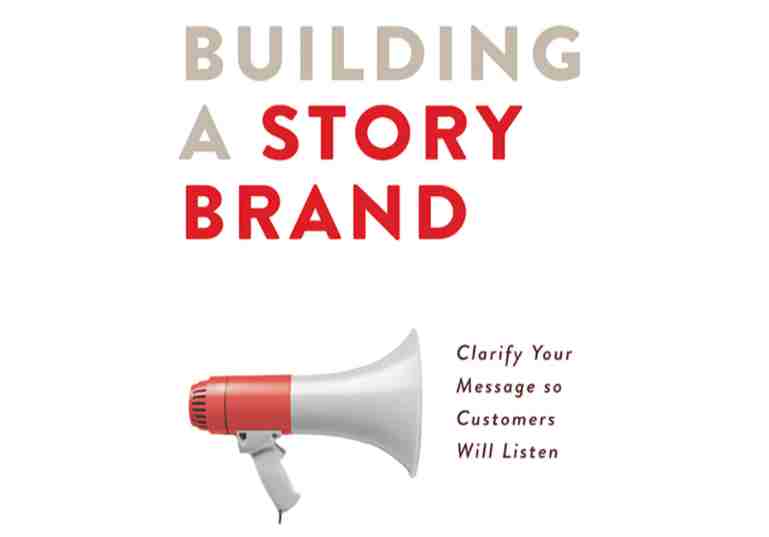Most brands waste a huge amount of money on marketing. The reason is simple. Most businesses hire graphic designers to build their websites and their collateral material. Graphic designers have degrees in design and have lots of coding knowledge. However, most have very limited skills when it comes to crafting messages that prospects can relate to and which follow the proven story brand framework that makes the prospect the hero. Graphic design companies are more than happy to take your money and incorporate the latest fads, regardless of the results they deliver. Websites don’t sell things – words do. If you have not clarified your message in the eyes of your prospect, they will not listen.
There are two critical mistakes brands make when they talk about their products or services.
Message Not Focused on Survive and Thrive
The first mistake brands make is they fail to focus on the aspects of their offer that will help the prospect survive and thrive. The human brain is constantly exposed to information. There are way too many things to process so it uses filters to sort out millions of unnecessary facts every day. You might have had a recent meeting with a colleague but your brain would never think to record the color of their shoes. Why? Because our brains don’t need to know the color of a person’s shoes to survive. The subconscious is always categorizing and organizing information and when we talk publicly about our brand or our company’s goals to a prospect, it does not rise to the level of survival or thriving and our words are simply ignored by their brains. Processing information requires the brain to burn calories. Burning too many calories goes against the brain’s primary job to help us survive and thrive.
Message Takes Too Much Effort
The second mistake brands make is causing the prospect to burn too many calories to understand their offer. While the brain represents just 2% of a person’s total body weight, it consumes 20% of the body’s energy. If you gave your brain a demanding mental task, its energy requirements increase. So, when having to process too much information, the brain begins to ignore the source to conserve calories. Imagine that every time you talk to a customer about your products or services, they have to start running on a treadmill. How long do you think they’re going to pay attention? Not long I would guess. And this is exactly what happens when you share your elevator pitch or when they visit your website. A prospect starts burning calories to process the information you’re trying to share.
Deliver Your Brand Message in a Story
Every business has an enemy. And that enemy is noise. What most people call marketing is really just clutter and confusion scattered all over their website, emails, and ads. Trying to filter out a message in all the noise is taxing for the brain, so as a defense to avoid burning too much energy to decern the meaning of the noise, the brain simply ignores the information.
So, what is the solution? Tell your message in a story. The brain is a story addict, always on the hunt for a character. When you create a story that relates to your brand, you create a map that customers can follow to engage with your products or services.
Donald Miller in his book Building a Story Brand describes what he calls the story brand framework. He says that to clarify your story message, you’re going to need a story formula. The story brand framework is a way to organize your thinking, reduce your marketing effort, and eliminate confusion. That story brand framework Miller postulates consists of seven elements. Every successful story needs a character who wants something, encounters a problem before they reach the peak of their despair, a guide who steps into their lives and gives them a plan, and calls them to action. That action helps them avoid failure and achieve success.
Related post: The 5-Step Process Used In Infomercials You Need To Use
In the movie The Hunger Games, the main character Katniss has a problem, she must kill or be killed. Along comes a guide, Haymitch who acts as a mentor and gives her a plan she needs to follow to win over the public and gain more sponsors. The plan gives her the resources to survive and prevail in the competition.
Businesses can use this same story brand framework to keep the prospect engaged with their brand. Businesses can also use the story brand framework to communicate their culture to employees and stakeholders in very few words.
The story brand framework is not something that ends up being directly shared with prospects or employees. Instead, it creates talking points that businesses can use to improve their marketing and messaging. The concept uses the framework of a story because people are addicted to stories and stories are easy to remember.
Donald Miller in his book Building a Story Brand describes the seven elements that make up the story brand framework.
Story Brand Framework – Character
The first step in the story brand framework is to identify the character in your story. The character in your business’s story is your prospect. The prospect always needs to be the hero in the story and it should never be your brand that comes out as the hero. Once you identified your story’s character, ask what they want as it relates to your brand’s promise.
The catalyst for any good story is that the hero wants something. The rest of the story’s journey is about discovering whether the hero will get what they want.
For example, if you are a financial adviser, your prospect wants a plan for their retirement. If you are a fine dining restaurant, the prospect wants a meal everyone will remember. If you are a real estate agent, the prospect wants a home they’ve always dreamed about. What does your prospect want?
Story Gap
In cinematic terms, when you identify the character’s desire, it opens what screenwriters call a story gap. The idea is that screenwriters place gaps between the character and what they want. Moviegoers pay attention when there is a story gap because they wonder if and how the gap is going to be closed.
In business, when your story fails to clearly define what your prospect wants, it also fails to open a story gap. Without the story gap, the customer is not motivated to engage with you because there’s no question in their mind that demands resolution.
One of the biggest mistakes many organizations make is failing to narrow down the prospect’s ambitions to a single focus that they can use as a story gap. Too many businesses have a dozen things they think their customers want and they try to mention them all in their marketing copy. This causes confusion and noise and the prospect will disengage with your brand.
By defining something the customer wants that you can connect to their desire to survive and thrive, you open up a very enticing story gap. Some examples of surviving and thriving story gaps you can include in your story brand framework are:
- Conserving their financial resources
- Conserving their time
- Helping them build social networks
- Causing them to gain status
- Allowing them to accumulate resources
- Reinforcing their desire to be generous
- Feeding their desire for meaning
Story Brand Framework – Problem
Once you have identified the character in your story brand framework, you need to define their problem. In cinematic terms, every story has to have a villain, an external problem the character must face, an internal problem the character must deal with, and a philosophical problem.
Story Villain
So how do you talk about the customers’ problems? Begin by looking at the root of where their conflict comes from. Every problem leads back to a villain. Luke Skywalker had Darth Vader and Batman had the Joker. The villain represents the barrier between the character and what they want. If you want your prospect’s ears to perk up when you talk about your products and services, position them as the weapon they can use to defeat their villain. Just to be clear, the villain does not have to be a person. Remember Superman had kryptonite.
The villain should be the source of the prospect’s frustration. For a vacuum company, the villain in a homeowner’s story might be the dreaded dust bunnies. For a tax accountant, the prospect’s villain is the IRS.
The villain needs to be 100% relatable to the prospect and they should immediately recognize it as something that is their root problem. Moreover, the villain should be singular. One villain is enough.
What most companies miss is the fact that the problem the villain initiates can be broken down into external, internal, and philosophical problems for the character. These three levels of problems work together to capture the prospect’s imagination. While the villain initiates the problem, the prospect has an external problem that causes them to experience internal frustration that they see as philosophically wrong.
For example, in The Hunger Games, the villain was President Snow. The external problem was Katniss’s need to survive. Her internal problem was that she couldn’t resort to indiscriminately killing others, and the philosophical problem was dictatorship vs. democracy.
External Problems
External problems are often physical and tangible problems that the character must overcome. In a movie plot, it might be a ticking time bomb or runaway bus. For a business, list the external problems your products or solutions solve for the customer. However, you’d be shortsighted to think that the only reason people call you, walk through your doors or even visit your website is just to resolve their external problem, which is why you need to look at their internal and philosophical problems as well.
Internal Problems
By limiting your message to only a prospect’s external problems, you neglect the parameter that costs many brands thousands of potential customers. Companies tend to sell solutions to external problems but people often buy solutions to internal problems.
In movies, the internal problems are usually contained in the character’s back story. It might be a failed career, self-doubt, being too young, etc. The internal problem that most prospects have is the following: Do I have what it takes? That question makes them feel frustrated, incompetent, and confused.
Steve Jobs understood how important appealing to a prospect’s internal problems was. Jobs recognized that most people were not buying personal computers because they felt intimidated by them and wanted a simpler user interface. CarMax understood that dealing with a used car salesman was the internal problem their customers faced. Starbucks understood that customers wanted to feel more sophisticated, even if they could not pay for their car or rent, and took a product that Americans were used to paying 50¢ for and charged them $3 to $4 to give them a sense of status.
If you have a house painting business, the prospect’s external problem might be an unsightly home. However, their internal problem may be a sense of embarrassment they feel about having the ugliest home on the block.
Philosophical Problems
Philosophical problems deal with the question of “why”. Why is it important for Tommy Boy to save his dad’s business? The philosophical problem can best be talked about using the terms “ought” and “shouldn’t”. Bad people or businesses shouldn’t be allowed to win. Or people or businesses ought to all be treated fairly.
Story Problem Examples:
Electric vehicles
- Villain = gas-guzzling cars
- External problem = I need a car
- Internal problem = I want to be an early adopter of new technology
- Philosophical problem = my car choice ought to help save the planet
Financial planning
- Villain = financial firms that don’t listen to their customers
- External problem = I need investment help
- Internal problem = financial investments confuse me
- Philosophical problem = if I’m going to invest my money, I deserve an adviser who will fully explain all my options to me in person.
Story Brand Framework – The Guide
Many brands portray themselves as the hero that can swoop in and save the day. However, according to author Donald Miller, most businesses are doing it all wrong. The hero in the story needs to be the prospect and not the business. The business should be merely the trusted guide in the prospect’s story, not the hero. Better to be Yoda than Skywalker.
Prospects are not looking for another hero. They are looking for a guide. Companies that position themselves as the hero unknowingly compete with their potential customers. This is particularly common in young brands who believe they need to prove themselves. When a company positions itself as the hero, prospects tend to remain distant. When they hear you talking about how great your business is, they start to wonder if they are competing with you for scarce resources.
Prospects have two basic questions when it comes to their guide: “Can I trust this person?” and “Can I respect this person?”. To address these two questions, two mental triggers will help prospects recognize your business as their guide. One is “empathy” and the other is “authority”.
Story Guide Empathy
When you empathize with your prospects, you create a bond of trust by showing you understand them and what they’re going through. Once you’ve identified the customer’s internal problems, you need to let them know that you understand and would like to help them find a resolution. Real empathy is letting the customer know that we see them as we see ourselves. Prospects look for companies they have something in common with, which is why empathy is so powerful.
Story Guide Authority
When it comes to authority, nobody likes a narcissist know-it-all. The best way to show authority is to have others talk about how good you are or how you helped them. This is why word-of-mouth marketing is powerful. Here are four ways that you can demonstrate authority without being perceived as bragging:
- Testimonials: let others do the talking about you.
- Statistics about how many satisfied customers you helped or how much money you have saved them.
- Awards you won.
- Logos for recognized businesses that you have helped.
Story Brand Framework – Plan
What prospects are looking for is a clear path that takes away any confusion they may have about doing business with you. Prospects are looking for a philosophy they can embody or a series of steps they can take to solve a problem.
When you have positioned yourself as their guide, you are already in a relationship with them, however, making a purchase is not a characteristic of a relationship. When a customer places an order with you, they are essentially saying that “I’m convinced that you can help me solve my problem and I’m willing to put some skin in the game and part with some of my hard-earned money.”
Committing to buy is always risky for prospects because as soon as they make it, they lose something. Most customers are not going to take that risk just yet. Prospects subconsciously ponder when they hover over your “Buy Now” button and wonder “What if it doesn’t work?” or “Am I a fool for buying this?” To ease our prospect’s concerns, you need to provide a series of steps and remove as many risks as possible to increase their comfort level in doing business with you.
The plan is the bridge that the prospect will use to reach their goal. Mickey Goldmill, the boxing coach in Rocky, gave Rocky Balboa an unorthodox training program to compete for the heavyweight boxing championship. Peter Brand gave Billy Bean in the movie Moneyball a way to use sabermetrics to outcompete better-funded teams.
In business, effective story plans do one of two things. They either clarify how somebody can do business with you or they remove the sense of risk somebody might have if they are considering doing business with you. To that end, there are two basic types of plans, a process plan, and an agreement plan.
Process Plan
The key to a process plan is to alleviate confusion. The process plan describes the steps a prospect needs to take to buy your product and/or the steps the customer needs to take to use your product after they buy it.
A good process plan should combine both pre and post-purchase steps. A pre-process plan tells the prospect how to buy from you. A post-process plan tells the prospect how to use what they bought from you. And a combination plan tells the prospect how to buy and then use what you sell.
If you’re selling hiking boots online, the pre-process plan might look like this:
- Find your size using the online size guide.
- Add the appropriate size to your online cart.
- Click checkout.
The post-process plan after they purchased and received the boots in the mail might look like this:
- Try on the boots. They should not pinch your toes or rub anywhere.
- Walk around your house to test the fit.
- Climb a set of stairs to simulate a trail.
- If they still feel good, go for a hike. If not, put the boots back in the box and use the included pre-printed return label to return the boots for a full refund.
A combination process plan would simply combine both pre and post-process plans.
The goal of a process plan is to clear up any customer confusion. Process plans should have between 3 and 6 steps. If you need more than six steps, divide steps into phases, such as pre and post-phases. A long list can create confusion.
Agreement Plan
The agreement plan is about alleviating fears to make the prospect confident enough to buy from you. An agreement plan is a list of promises you make to your customers to help them overcome their fears of doing business with you. Agreement plans never deal with the external problem, instead, they focus on the internal one. Agreement plans are generally not something that you feature on your homepage.
There are two types of agreement plans:
Risk reduction plans reduce the chance of a prospect buying an unsatisfactory product. For example, many electronics companies certify that their refurbished products have been tested and passed a quality control standard.
Shared value plans demonstrate to the prospect that a brand has something in common with them, which creates trust. For example, Whole Foods’s agreement plan is their list of values that include their commitment to responsible product sourcing.
Regardless of which plan you use, either a process or agreement plan, you should give it a name to increase the perceived value. For example, “Easy installation plan”, or the “World’s best night’s sleep plan”.
Story Brand Framework – Call to action
Prospects do not take action unless they are challenged to do so and they will take action only when your story challenges them to do so. You would be surprised at how many companies don’t create an obvious call to action for their prospects. A call to action involves communicating a clear and direct step that your prospects should take to overcome their challenges.
There are two types of calls to action that have worked for most clients.
Transitional Call to Action
Transitional calls to action are used to deepen the relationship and build trust with a prospect. A transitional call to action contains less risk for the prospect and usually involves offering a prospect something for free. Rather than asking them to exchange money, as in the more traditional direct calls to action, you are only asking the prospect for their email address in exchange for something of value. Transitional calls to action often include something such as downloading a free eBook, signing up for a free monthly newsletter, getting a free sample, or signing up for a 30-day free trial. Transitional calls to action act as the on-ramp to building trust with the prospect.
A good transitional call to action does three powerful things for your business:
- It stakes a claim to your territory if you want to be known as a thought leader by providing some educational-based content.
- It creates reciprocity. Since the prospect received something of value at no cost, it created a network deposit that they may feel compelled to pay back later by making a purchase or recommending your business.
- It positions you as their guide when you help them solve a part of their problem for free.
Direct Call to Action
Direct calls to action are used to ask a prospect to take a specific action. A direct call to action is something that leads to the sale, such as a “Buy Now” button or at least is the first step down the path that leads to a sale such as a “Schedule an Appointment” button.
Direct calls to action should be clear and compelling and require more than just the prospect’s email. The direct call to action button needs to be obvious and stand out from the copy with either a different color or larger or bold type font. The best place to position your direct call to action is in the top right corner of your website. Its location should not be cluttered with a bunch of other buttons. The same button should be repeated above the fold, in the middle of the page, and again at the bottom of the page.
Many brands think that having multiple direct calls to action is overselling. However, the truth of the matter is that when you try to sell passively, you communicate a lack of belief in your own product. A sales mentor once told me:
“If you believe in your product or service, you owe it to your prospect to ask for the sale.”
When you don’t clearly ask for the sale, the prospect senses weakness. Prospects are not looking for brands that are filled with doubts, they want confirmation that your business has a solution to their problems that can change their story for the better.
Once you begin using both types of calls to action, prospects will understand exactly what you want them to do and decide whether or not to let your business play a role in their story.
Story Brand Framework – Avoid Failure
Every human being is trying to avoid a tragic ending. If there’s nothing to be gained or lost, nobody cares. If there’s nothing at stake for the prospect to buy your product or service, why should they buy it? You must show the prospect the cost of not doing business with you. Either they will miss out on an opportunity or lose something they currently have.
In the 1980s, Wendy’s fast-food chain asked America “Where’s the beef?” The implication was that Wendy’s competitors were not using enough meat. So, what’s at stake for choosing another brand over Wendy’s? You lose out on getting more meat in your burger.
Fear of loss or loss aversion is also a very powerful motivator. A long-running and popular series of commercials that deal with loss aversion is the Allstate Insurance “Mayhem” guy.
What will the prospect lose if they don’t buy your product or service right now? Most brands don’t bring up the negative stakes enough when they tell their stories.
In the book Building Communication Theory the authors share a four-step process they called the fear appeal:
- Make the prospect know they are vulnerable to a threat.
“Nearly 30% of all homes have evidence of termite infestations.” - Make the prospect know that since they are vulnerable, they should take some type of action to reduce their vulnerability.
“Since nobody wants termites, you should do something about it to protect your home.” - Make the prospect know about a specific call to action that can protect them from the risk.
“We offer a complete home inspection and treatment plan that will ensure your house is free of termites.” - Challenge the customer to take a specific action.
“Call today to schedule your home inspection and treatment.”
Story Brand Framework – Success
Never assume that your prospect understands how your brand can change their lives. You must tell them. You must tell your prospects how great their life would be if they bought your product or service. Every prospect wants to be taken somewhere. If you don’t tell them where you are taking them, they will engage with another company.

You need to paint the vision of your customers’ future. Have you ever noticed that no matter what a company is selling, above the fold they will always show pictures of happy consumers? The above example comes from local hospital websites. The pictures are not of their doctors treating patients, or showing that they have state-of-the-art medical equipment. This is not a mistake. They want you to see what success will look like. Remember, the prospect needs to be the hero in the story, and if they take you up on your offer, the prospect will end up happy just like the people in your photos.
If you’re selling flooring, your website might show a happy mom picking up a child from a beautiful and sparkling clean floor.
If you’re selling a preschool program, your website should show kids in a classroom having a great time in the environment that you provide.
Whatever it is you sell, show happy people engaged with your product.
There are three dominant story endings:
- Winning some type of power or position. The need for status is a powerful motivator. To this, you can offer a premier level of access (Exclusive airport lounge), create scarcity (Private stock), offer premium-level (Diamond-level member), or offer identity associated with luxury (Rolex).
- A union that makes the prospect whole. There is the human need for something external to create a sense of completeness. To do this, you can reduce anxiety (job well done), reduced workload (all-in-one software), or more time (automation).
- Ultimate self-reflection or acceptance. Most people have the desire to reach their full potential. To do this, you can offer inspiration (Red Bull), acceptance (Curves gym), or transcendence (Patagonia).
Conclusion
The story brand framework uses the concept of a story because everyone is addicted to stories and stories are easy to remember. A key takeaway is that brands need to make sure the prospect is the hero in their own story and your business is portrayed as their guide who has a plan to lead them to a successful outcome.
The story formula is made up of seven elements:
A clear image of a character who wants something
A problem that the character (the prospect) encounters in their lives
A guide (your business) that steps into their lives
The guide gives the prospect a step-by-step plan to follow
The company provides a clear call to action so that the prospect knows what to do
The prospect knows what is at stake and how to avoid failure
And ends with a vision of what success looks like
The story brand framework, once completed, is a lens that you can use to reexamine your website to make sure that your message is clear.
In a subsequent post, we will look at how you can use your newly created story brand to create a story brand roadmap, a one-line answer to the question “What do you do?”, a lead generator, email drip campaigns, and collect and tell stories of transformations, and generate referrals.
How can you employ a story message?












